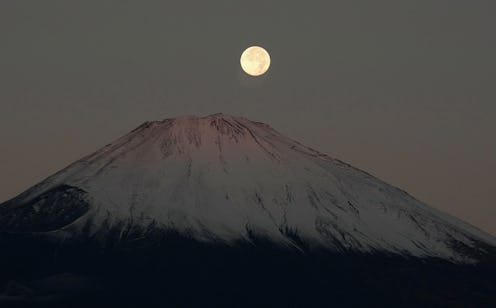Life
Humans Have Been Obsessed With The Winter Solstice Throughout History — Here's Why

There are few things that are easy to discern about the winter solstice: it marks the official start of the winter season, and it's the shortest day of the year. But what the winter solstice actually means, and how the observation came to be, is a bit more complicated. You see, the winter solstice has come to mean different things to different groups of people over time. From religious references, to spiritual symbolism, the winter solstice marks an important shift in the year.
Technically speaking, the solstice occurs when the sun aligns itself directly over the Tropic of Capricorn — which is 23.5° south latitude. This is the lowest the sun will rise all year, with an arc so shallow it will create the illusion that the sun is rising and setting in the same exact place. This illusion is actually what the solstice is named after. The term is derived from the Latin word "solstitium," which translates to "the Sun stands still".
The dates of this event can vary from one to two days before or after Dec. 21. This year, the solstice will occur at exactly 11:28 a.m. EST on Dec. 21 — just a fleeting moment of celestial alignment. The total daylight hours for the U.S. will range from 10.5 to 8.5 hours of sunlight — whereas the summer solstice in June brought in between 16 to 13 hours of sunlight. But because we've been gradually moving towards this position, you might not notice that the day is any shorter than the days leading up to the solstice or following it. And that's because it's only a matter of minutes.
Because the winter solstice has the shortest amount of sunlight in the year, it also has the longest amount of darkness in the year. That's logical reasoning, right? Starting directly after the solstice, on Dec. 22, a shift will occur, and each day will have approximately another minute of daylight. Because of these two factors, the solstice holds a lot of spiritual value. Early civilizations were excited by the return of the sun that would begin after the solstice and would celebrate because of it. In Scandinavian and Germanic pagan culture, it was believed that people burned Yule logs as a symbolic gesture of gratitude for the light.
In Ireland, it is believed that the prehistoric monuments called the Stonehenge and the Newgrange, were created to celebrate the solstice, as they line up perfectly with the setting sun only on those days. Further leading people to believe that these dates were revered as both culturally and spiritually relevant and important.
In Iran, a festival called Yalda (which means "birth") is celebrated on the winter solstice to celebrate the not only the beginning of winter, but the triumph of lightness taking over darkness. On this night, people stay awake until the wee hours of the morning to bid the fall farewell and to look forward to the return of daylight.
Astrologically speaking, the winter solstice is linked to the planet Saturn. This is due to the fact that during the solstice, the sun is moving into Saturn’s ruling constellation of Capricorn, taking on some of the signs grounding qualities. With the end of the year approaching, but the spring far off, astrologists view the solstice as a reminder to slow things down, to pace yourself, and prepare for a long, steady, and healthy winter ahead. Aka, it's fine to celebrate the solstice on Dec. 21, but don't blow off too much energy, you'll need to harness it for the rest of the winter.